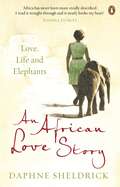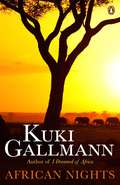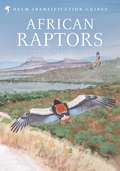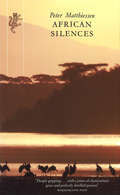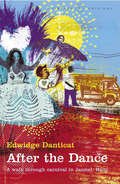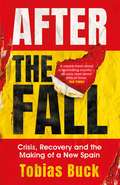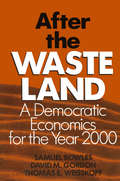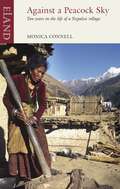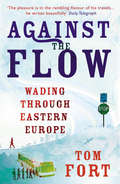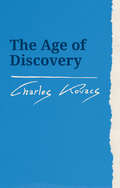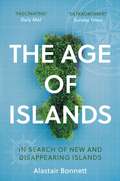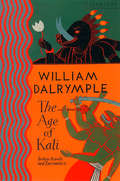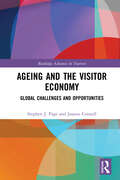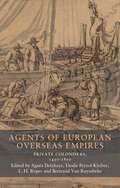- Table View
- List View
The African Correspondence of Sir Joseph Banks, 1767–1820: Volume III 1804–1820
by Neil ChambersThis edition brings together in three fully edited volumes the correspondence and associated papers of Sir Joseph Banks regarding European and especially British exploration of Africa from 1767–1820, for the first time publishing this globally scattered material in one place, thereby revolutionizing its availability and understanding of the activities of a key figure who helped organize and publish a series of missions to penetrate the African interior, mainly from West Africa and by crossing the Sahara from Cairo and Tripoli. Banks was a founder in 1788 of the African Association, which mounted many of these missions, including those of Mungo Park to explore the River Niger, and J.L. Burkhardt exploring Syria, Arabia and Egypt. At the time, little was known about the African interior, its peoples, kingdoms and resources, and the aim of the African Association under Banks was to discover what lay there, to make contact with and study its societies, to map them and their lands and help establish trading links. Banks also maintained a lively correspondence with British diplomatic representatives in North Africa, such as James Mario Matra at Tangier and Henry Salt in Cairo, who were a rich source of news. Moreover, as unofficial director of the royal gardens at Kew he sent pioneering plant collectors to gather plants in South Africa, vastly boosting knowledge of this region’s important flora. At home, he corresponded with politicians, government officials, entrepreneurs, navigators, naturalists and campaigners like William Wilberforce about a great range of issues surrounding Africa. This work is multi-disciplinary and will stand alongside existing series of Banks’s correspondence published by Neil Chambers (Scientific Correspondence, 2007; Indian and Pacific Correspondence, 2007–14). It will appeal to scholars of African history in the Early Modern Period, to those studying exploration and collecting as well as those interested in natural history, the history of science, geography, cartography and the Enlightenment. An Introduction, detailed Calendar of Correspondents, Timelines for each volume and a comprehensive Index supplement the footnotes to nearly 800 documents included in this fascinating and comprehensive new series.
The African Correspondence of Sir Joseph Banks, 1767–1820: Volume II: 1795–1803
by Neil ChambersThis edition brings together in three fully edited volumes the correspondence and associated papers of Sir Joseph Banks regarding European and especially British exploration of Africa from 1767–1820, for the first time publishing this globally scattered material in one place, thereby revolutionizing its availability and understanding of the activities of a key figure who helped organize and publish a series of missions to penetrate the African interior, mainly from West Africa and by crossing the Sahara from Cairo and Tripoli. Banks was a founder in 1788 of the African Association, which mounted many of these missions, including those of Mungo Park to explore the River Niger, and J.L. Burkhardt exploring Syria, Arabia and Egypt. At the time, little was known about the African interior, its peoples, kingdoms and resources, and the aim of the African Association under Banks was to discover what lay there, to make contact with and study its societies, to map them and their lands and help establish trading links. Banks also maintained a lively correspondence with British diplomatic representatives in North Africa, such as James Mario Matra at Tangier and Henry Salt in Cairo, who were a rich source of news. Moreover, as unofficial director of the royal gardens at Kew he sent pioneering plant collectors to gather plants in South Africa, vastly boosting knowledge of this region’s important flora. At home, he corresponded with politicians, government officials, entrepreneurs, navigators, naturalists and campaigners like William Wilberforce about a great range of issues surrounding Africa. This work is multi-disciplinary and will stand alongside existing series of Banks’s correspondence published by Neil Chambers (Scientific Correspondence, 2007; Indian and Pacific Correspondence, 2007–14). It will appeal to scholars of African history in the Early Modern Period, to those studying exploration and collecting as well as those interested in natural history, the history of science, geography, cartography and the Enlightenment. An Introduction, detailed Calendar of Correspondents, Timelines for each volume and a comprehensive Index supplement the footnotes to nearly 800 documents included in this fascinating and comprehensive new series.
The African Correspondence of Sir Joseph Banks, 1767–1820: Volume I: 1767–1794
by Neil ChambersThis edition brings together in three fully edited volumes the correspondence and associated papers of Sir Joseph Banks regarding European and especially British exploration of Africa from 1767–1820, for the first time publishing this globally scattered material in one place, thereby revolutionizing its availability and understanding of the activities of a key figure who helped organize and publish a series of missions to penetrate the African interior, mainly from West Africa and by crossing the Sahara from Cairo and Tripoli. Banks was a founder in 1788 of the African Association, which mounted many of these missions, including those of Mungo Park to explore the River Niger, and J.L. Burkhardt exploring Syria, Arabia and Egypt. At the time, little was known about the African interior, its peoples, kingdoms and resources, and the aim of the African Association under Banks was to discover what lay there, to make contact with and study its societies, to map them and their lands and help establish trading links. Banks also maintained a lively correspondence with British diplomatic representatives in North Africa, such as James Mario Matra at Tangier and Henry Salt in Cairo, who were a rich source of news. Moreover, as unofficial director of the royal gardens at Kew he sent pioneering plant collectors to gather plants in South Africa, vastly boosting knowledge of this region’s important flora. At home, he corresponded with politicians, government officials, entrepreneurs, navigators, naturalists and campaigners like William Wilberforce about a great range of issues surrounding Africa. This work is multi-disciplinary and will stand alongside existing series of Banks’s correspondence published by Neil Chambers (Scientific Correspondence, 2007; Indian and Pacific Correspondence, 2007–14). It will appeal to scholars of African history in the Early Modern Period, to those studying exploration and collecting as well as those interested in natural history, the history of science, geography, cartography and the Enlightenment. An Introduction, detailed Calendar of Correspondents, Timelines for each volume and a comprehensive Index supplement the footnotes to nearly 800 documents included in this fascinating and comprehensive new series.
The African Correspondence of Sir Joseph Banks, 1767–1820: Volume I: 1767–1794
by Neil ChambersThis edition brings together in three fully edited volumes the correspondence and associated papers of Sir Joseph Banks regarding European and especially British exploration of Africa from 1767–1820, for the first time publishing this globally scattered material in one place, thereby revolutionizing its availability and understanding of the activities of a key figure who helped organize and publish a series of missions to penetrate the African interior, mainly from West Africa and by crossing the Sahara from Cairo and Tripoli. Banks was a founder in 1788 of the African Association, which mounted many of these missions, including those of Mungo Park to explore the River Niger, and J.L. Burkhardt exploring Syria, Arabia and Egypt. At the time, little was known about the African interior, its peoples, kingdoms and resources, and the aim of the African Association under Banks was to discover what lay there, to make contact with and study its societies, to map them and their lands and help establish trading links. Banks also maintained a lively correspondence with British diplomatic representatives in North Africa, such as James Mario Matra at Tangier and Henry Salt in Cairo, who were a rich source of news. Moreover, as unofficial director of the royal gardens at Kew he sent pioneering plant collectors to gather plants in South Africa, vastly boosting knowledge of this region’s important flora. At home, he corresponded with politicians, government officials, entrepreneurs, navigators, naturalists and campaigners like William Wilberforce about a great range of issues surrounding Africa. This work is multi-disciplinary and will stand alongside existing series of Banks’s correspondence published by Neil Chambers (Scientific Correspondence, 2007; Indian and Pacific Correspondence, 2007–14). It will appeal to scholars of African history in the Early Modern Period, to those studying exploration and collecting as well as those interested in natural history, the history of science, geography, cartography and the Enlightenment. An Introduction, detailed Calendar of Correspondents, Timelines for each volume and a comprehensive Index supplement the footnotes to nearly 800 documents included in this fascinating and comprehensive new series.
The African Correspondence of Sir Joseph Banks, 1767–1820: Volume III 1804–1820
This edition brings together in three fully edited volumes the correspondence and associated papers of Sir Joseph Banks regarding European and especially British exploration of Africa from 1767–1820, for the first time publishing this globally scattered material in one place, thereby revolutionizing its availability and understanding of the activities of a key figure who helped organize and publish a series of missions to penetrate the African interior, mainly from West Africa and by crossing the Sahara from Cairo and Tripoli. Banks was a founder in 1788 of the African Association, which mounted many of these missions, including those of Mungo Park to explore the River Niger, and J.L. Burkhardt exploring Syria, Arabia and Egypt. At the time, little was known about the African interior, its peoples, kingdoms and resources, and the aim of the African Association under Banks was to discover what lay there, to make contact with and study its societies, to map them and their lands and help establish trading links. Banks also maintained a lively correspondence with British diplomatic representatives in North Africa, such as James Mario Matra at Tangier and Henry Salt in Cairo, who were a rich source of news. Moreover, as unofficial director of the royal gardens at Kew he sent pioneering plant collectors to gather plants in South Africa, vastly boosting knowledge of this region’s important flora. At home, he corresponded with politicians, government officials, entrepreneurs, navigators, naturalists and campaigners like William Wilberforce about a great range of issues surrounding Africa. This work is multi-disciplinary and will stand alongside existing series of Banks’s correspondence published by Neil Chambers (Scientific Correspondence, 2007; Indian and Pacific Correspondence, 2007–14). It will appeal to scholars of African history in the Early Modern Period, to those studying exploration and collecting as well as those interested in natural history, the history of science, geography, cartography and the Enlightenment. An Introduction, detailed Calendar of Correspondents, Timelines for each volume and a comprehensive Index supplement the footnotes to nearly 800 documents included in this fascinating and comprehensive new series.
An African Love Story: Love, Life and Elephants
by Dame Daphne SheldrickDaphne Sheldrick's best-selling love story of romance, life and elephants, An African Love Story: Love, Life and Elephants is an incredible story from Africa's greatest living conservationist.A typical day for Daphne involves rescuing baby elephants from poachers; finding homes for orphan elephants, all the while campaigning the ever-present threat of poaching for the ivory trade.An African Love Story is the incredible memoir of her life. It tells two stories - one is the extraordinary love story which blossomed when Daphne fell head over heels with Tsavo Game Park and its famous warden, David Sheldrick. The second is the love story of how Daphne and David, who devoted their lives to saving elephant orphans, at first losing every infant under the age of two until Daphne at last managed to devise the first-ever milk formula which would keep them alive. 'Compulsively readable', Mail on Sunday'An enchanting memoir', TelegraphDaphne Sheldrick has spent her entire life in Kenya. For over 25 years, she and her husband, David, the famous founder of the the giant Tsavo National Park, raised and rehabilitated back into the wild orphans of misfortune from many different wild species. These included elephants, rhinos, buffaloes, zebra, eland, kudu, impala, warthogs and many other smaller animals. In 2006 she was made Dame Commander of the British Empire by the Queen.
African Nights: True Stories From The Author Of I Dreamed Of Africa (Ulverscroft Large Print Ser.)
by Kuki GallmannStunningly repackaged, Kuki Gallmann's African Nights vividly portrays the harsh and beautiful landscapes of Africa.Africa evokes a deep sense of mystery. It is a place that retains what most of the world has lost: space, roots, traditions, awesome beauty, true wilderness, rare animals, and extraordinary people. In this wonderful and haunting collection of stories, Kuki Gallmann writes of her life in Africa, where every day brings challenge and adventure. African Nights is a treasury of memories, in which fascinating people and places are brought to life. It he healing powers Africa can have on those who embrace the land as a place of mystery, superstition, danger, and beauty.'Captures perfectly the magic of Kenya, creating an almost overwhelming picture of beauty and drama, pain and joy, death and resurrection . . . Her discovery of African culture, with its mystery and danger, is recounted in spare, lyrical prose' New York Times'Powerful, poetic, unbearably moving: I wept' Clare Francis (on I Dreamed of Africa)Kuki Gallmann was born near Venice and moved to Kenya in 1972 with her husband and young son. Following their deaths, she set up the Gallmann Memorial Foundation to promote new ways of combining development and conservation, and to provide sponsorship for the education of Kenyans. Her first book, I Dreamed of Africa, was published in 1991 to international acclaim and it became a world-wide bestseller. She lives in Kenya with her daughter and her dogs.
African Raptors (Helm Identification Guides)
by Bill Clark Rob DaviesThe most comprehensive guide to African raptors ever published.Africa has the most diverse range of raptors of any continent, with almost a third of the world's species occurring in the region. This comprehensive new book treats all of these species in impressive detail, with emphasis on their field identification. A full range of plumages is illustrated for each species, with artwork by raptor specialist Rob Davies. The authoritative text treats the identification of both perched and in-flight birds, and covers all major races, ages, plumages and morphs. These texts are accompanied by up-to-date distribution maps and a range of fabulous colour photographs from some of the world's leading bird photographers, again covering as broad a range of ages and subspecies as possible. This new Helm Identification Guide will be an essential reference for all birders and ornithologists with an interest in raptors.
African Raptors (Helm Identification Guides)
by Bill Clark Rob DaviesThe most comprehensive guide to African raptors ever published.Africa has the most diverse range of raptors of any continent, with almost a third of the world's species occurring in the region. This comprehensive new book treats all of these species in impressive detail, with emphasis on their field identification. A full range of plumages is illustrated for each species, with artwork by raptor specialist Rob Davies. The authoritative text treats the identification of both perched and in-flight birds, and covers all major races, ages, plumages and morphs. These texts are accompanied by up-to-date distribution maps and a range of fabulous colour photographs from some of the world's leading bird photographers, again covering as broad a range of ages and subspecies as possible. This new Helm Identification Guide will be an essential reference for all birders and ornithologists with an interest in raptors.
African Silences (Ediciones De Bolsillo/península Ser. #Vol. 33)
by Peter MatthiessenAfrican Silences is a spellbinding and sobering journey through Africa’s ravaged wildernesses. In 1978 and again in 1986, Matthiessen travelled through Senegal, Gambia, the Ivory Coast, Zaire and the Central African Republic to examine the fate of West African wildlife. African Silences shows Matthiessen at his best, taking the reader on hair-raising flights over forest and savanna, high-speed dashes by car along dirt roads, and slow journeys by river boat and jungle track, to encounter rare and endangered animals – elephants, gorillas and rhinos amongst them – and the wildlife biologists who study and attempt to protect them.
After The Dance: A Walk Through Carnival in Jacmel, Haiti (Vintage Departures Ser.)
by Edwidge DanticatEdwidge Danticat had long been scared off from Carnival by a loved one, who spun tales of people dislocating hips from gyrating with too much abandon, losing their voices from singing too loudly, going deaf from the clamor of immense speakers, and being punched, stabbed, pummeled, or fondled by other lustful revelers. Now an adult, she resolves to return and exorcise her Carnival demons. During her journeys she traces the heroic and tragic history of the island, from French colonists and Haitian revolutionaries to American invaders and home-grown dictators. Danticat also introduces us to many of the performers, artists, and organizers who re-create the myths and legends that bring the Carnival festivities to life. When Carnival arrives, we watch as she goes from observer to participant and finally loses herself in the overwhelming embrace of the crowd. Part travelogue, part memoir, this is a lyrical narrative of a writer rediscovering her country along with a part of herself.
After the Fall: Crisis, Recovery and the Making of a New Spain
by Tobias BuckTobias Buck arrived in Madrid in December 2012, in time to celebrate the bleakest Christmas the city had seen in a generation. Capital and country were reeling from a series of economic shocks that had brought Spain to the brink of ruin. The housing boom had dramatically turned to bust, a large chunk of the nation's banking system was in state hands, businesses were closing across the country, debt was spiralling out of control and unemployment levels had reached a record high.AFTER THE FALL presents a rich and vivid portrait of contemporary Spain at a critical moment in the country's history. The book tells the story of Spain's long boom and sudden bust, the brutal economic crisis that followed, and the political and social aftershocks that reverberate to this day. It explores the origins of the separatist movement in Catalonia, and its bitter clash with the Spanish government that culminated in a failed secession referendum and a divisive declaration of independence. It looks at the legacy of the Civil War and Franco dictatorship, and the continuing struggle over historical memory in Spain today. Based on five years of reporting and hundreds of interviews, AFTER THE FALL takes the reader from the offices of power in Madrid and Barcelona to the villages of the Basque country, still haunted by the memory of political violence, and to the towns of Andalusia, where an entire generation has seen its economic hopes shattered. It describes how the country has been changed by the experience of migration, and why - after decades at the margins - the far-right eventually made a return to Spanish politics. For all the problems and challenges facing Spain today, we see that amid the ruins of the crisis, the search for a new Spanish model is already underway.
After the Waste Land: Democratic Economics for the Year 2000
by Samuel Bowles David M. Gordon Thomas E. WeisskopfThis critique of Reaganomics attempts to provide alternatives to both the supply experiments of the 1980s and neoliberal strategies of austerity. It presents arguments for economic democracy with a worker-oriented blueprint for improving productivity, growth, employment and economic justice.
After the Waste Land: Democratic Economics for the Year 2000
by Samuel Bowles David M. Gordon Thomas E. WeisskopfThis critique of Reaganomics attempts to provide alternatives to both the supply experiments of the 1980s and neoliberal strategies of austerity. It presents arguments for economic democracy with a worker-oriented blueprint for improving productivity, growth, employment and economic justice.
Against a Peacock Sky: Two years in the life of a Nepalese village
by Monica ConnellFor two years in the early 1980s, Monica Connell lived as a paying guest of Kalchu and Chola in the Nepalese village of Talphi. Gradually she was accepted as a member of the family, sharing its joys and sorrows as well as taking part in its various tasks, from mud plastering the house to rice planting in the terraced fields. The village, in the Jumla region of western Nepal, was ten days' walk from the nearest road, and its only contact with the outside world was through trading expeditions: north to Tibet for salt, and south to the Indian border for cotton and metalware. Connell vividly shares her experience of this remote way of life, and describes the dramas of village life with empathy and a sense of wonder- a boar hunt in winter, the wedding of a young neighbour and the magic of the full moon festival, when the gods descend to dance amongst the villagers.
Against Machismo: Young Adult Voices in Mexico City (n/a)
by Josué RamirezBased on fieldwork conducted among middle-class university students primarily at the national university (UNAM) in Mexico City, this study explores gender relations as reflected in the words macho and machismo. The author concludes that the students use them to denote aspects of their families of origin that they consider unfavorable and aspects of the cultural past that they wish to leave behind in their own lives. In capturing the lively and revealing conversations of these young voices, the author offers a compelling analysis of how gender concepts and identities are changing in contemporary Mexico City.
Against the Flow: Wading Through Eastern Europe
by Tom Fort'You have to be on your guard when you go back to special places. You may be able to locate them easily enough on the map, but maps tell only one story. Times change and places and people with them. The memory plays curious tricks, and things aren't always as you remember or expect.' Twenty years ago, Tom Fort drove his little red car onto the ferry at Felixstowe, bound for all points east. Eastern Europe was still a faraway place, just emerging from its half-century of waking nightmare, blinking, injured, full of fears but importantly full of hope too. Things were different then. Czechoslovakia was still Czechoslovakia, Russia was the USSR and the Warsaw Pact had not formally dissolved. But what did exist then, as they do now, were the rivers: the nations' lifeblood. It was along and by these rivers that Fort travelled around Eastern Europe meeting its people and immersing himself in its culture.Since that trip though, much has changed and in more recent years around one million Poles have settled in Britain. Fort's local paper has a Polish edition, his supermarket has a full range of Polish bread, sausage and beer and an influx of Polish businesses opened in his town centre. And it's not just the Poles, his gym has a Lithuanian trainer and the woman who cuts his hair is from Hungary. As a tide of people began to leave Eastern Europe and settle in the UK, Tom Fort started to wonder about what they were leaving behind and whether the friends he had made all those years ago remained. And so he decided to make the journey again, travelling against the flow of the steady human stream to explore the once familiar places. As he did so, many began to return as the recession took hold of Western Europe. Tom was keen to find out what had changed and how the places, people and way of life had moved on and of course fit in a spot of fishing along the way.
The Age of Discovery (Waldorf Education Resources Ser.)
by Charles KovacsAn overview of world history from the time of the Crusades to the Renaissance. Includes Saladin, Joan of Arc, Columbus, Magellan, Queen Elizabeth and Francis Drake. A resource for Steiner-Waldorf teachers of Class 7 (age 12-13).
The Age of Islands: In Search of New and Disappearing Islands
by Alastair Bonnett'Extraordinary... A fascinating and intelligent book.' Sunday TimesNew islands are being built at an unprecedented rate whether for tourism or territorial ambition, while many islands are disappearing or fragmenting because of rising sea levels. It is a strange planetary spectacle, creating an ever-changing map which even Google Earth struggles to keep pace with. In The Age of Islands, explorer and geographer Alastair Bonnett takes the reader on a compelling and thought-provoking tour of the world's newest, most fragile and beautiful islands and reveals what, he argues, is one of the great dramas of our time.From a 'crannog', an ancient artificial island in a Scottish loch, to the militarized artificial islands China is building in the South China Sea; from the disappearing islands that remain the home of native Central Americans to the ritzy new islands of Dubai; from Hong Kong and the Isles of Scilly to islands far away and near: all have urgent stories to tell.
The Age of Kali: Travels And Encounters In India (text Only)
by William DalrympleWilliam Dalrymple, who wrote so magically about India in ‘City of Djinns’, returns to the country in a series of remarkable essays.
Ageing and the Visitor Economy: Global Challenges and Opportunities (Routledge Advances in Tourism)
by Stephen J. Page Joanne ConnellThis significant volume is the first to use primary research evidence to examine tourism, ageing and the implications of an ageing population for the visitor economy. Adopting a multidisciplinary approach, this book offers insights into the new opportunities, threats and challenges that the growing ageing-tourism markets poses. The ageing population has created a demographic time bomb with a population structure that is skewed towards a growing proportion of older people. When this is combined with the impact of health conditions, such as dementia, the future shape of visitor demand and tourism behaviour is likely to change and face many new challenges, albeit at different rates in time and space. Chapters include cutting-edge insights into future issues, while interviews are used to illustrate and explain issues affecting ageing and tourism, creating a much-needed synthesis of the ageing–tourism nexus to demonstrate intellectual leadership around this theme. This book will be of great interest to all upper-level students, academics and researchers in the fields of tourism, hospitality, leisure studies, and health and social care.
Ageing and the Visitor Economy: Global Challenges and Opportunities (Routledge Advances in Tourism)
by Stephen J. Page Joanne ConnellThis significant volume is the first to use primary research evidence to examine tourism, ageing and the implications of an ageing population for the visitor economy. Adopting a multidisciplinary approach, this book offers insights into the new opportunities, threats and challenges that the growing ageing-tourism markets poses. The ageing population has created a demographic time bomb with a population structure that is skewed towards a growing proportion of older people. When this is combined with the impact of health conditions, such as dementia, the future shape of visitor demand and tourism behaviour is likely to change and face many new challenges, albeit at different rates in time and space. Chapters include cutting-edge insights into future issues, while interviews are used to illustrate and explain issues affecting ageing and tourism, creating a much-needed synthesis of the ageing–tourism nexus to demonstrate intellectual leadership around this theme. This book will be of great interest to all upper-level students, academics and researchers in the fields of tourism, hospitality, leisure studies, and health and social care.
Agents of European overseas empires: Private colonisers, 1450-1800 (Seventeenth- and Eighteenth-Century Studies #19)
by Agnès Delahaye, Elodie Peyrol-Kleiber, L.H. Roper and Bertrand Van RuymbekeAgents of European overseas empires involves contributors who specialise on often overlooked aspects of imperial endeavour: ‘private’ European interests, companies, merchants or courtiers, who conducted their own activities both with and without the benediction of polities. The chapters adopt intra- as well as inter-imperial perspectives and transport the reader to colonial America, the West Indies, the Cape of Good Hope, Batavia, or Ceylon, through the Dutch, English, French and Spanish empires. Agents of European overseas empires offers crucial insight on how these actors acquired profits and power and, in turn, laid the platforms for European global empires.
Agents of European overseas empires: Private colonisers, 1450-1800 (Seventeenth- and Eighteenth-Century Studies #19)
by Elodie Peyrol-Kleiber L. H. Roper Bertrand Van Ruymbeke Agnès DelahayeAgents of European overseas empires involves contributors who specialise on often overlooked aspects of imperial endeavour: ‘private’ European interests, companies, merchants or courtiers, who conducted their own activities both with and without the benediction of polities. The chapters adopt intra- as well as inter-imperial perspectives and transport the reader to colonial America, the West Indies, the Cape of Good Hope, Batavia, or Ceylon, through the Dutch, English, French and Spanish empires. Agents of European overseas empires offers crucial insight on how these actors acquired profits and power and, in turn, laid the platforms for European global empires.
AA Gill is Away
by Adrian Gill'Theatre, food, refugees: in Adrian's writing they're all linked up ... If you haven't read his book AA GILL IS AWAY, read it now. It was when he was away that he was at his best' Stephen DaldryA. A. Gill was probably the most read columnist in Britain. Every weekend he entertained readers of the SUNDAY TIMES with his biting observations on television and his unsparing, deeply knowledgeable restaurant reviews. Even those who objected to his opinions agree: his writing is hopelessly, painfully funny. He was one of a tiny band of must-read journalists and it was always a disappointment when the words 'A.A. Gill is away' appeared at the foot of his column. This book is the fruit of those absences: twenty-five long travel pieces that belie his reputation as a mere style-journalist and master of vitriol: this is travel writing of the highest quality and ambition.



